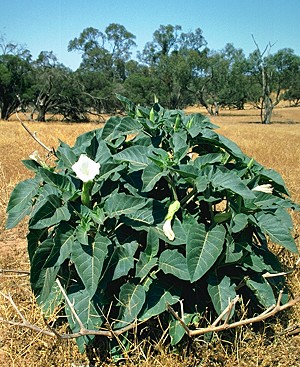
Synonymy
*Datura inoxia Miller, Gard. Dict. 8th edn, no. 5 (1768)
T: Cultivated from seeds collected in Vera Cruz, Mexico, Chelsea Phys. Gard. no. 1843; neo: BM, fide A.S. Barclay, Bot. Mus. Leafl. 18: 255 (1959).
[D. metel auct. non L.: J.M.Black, Fl. S. Austral. 2nd edn, 4: 755 (1957)]
Description
Stout annual herb, tomentose with erect, glandular hairs.
Mature leaves broadly ovate, the lamina up to 20 cm long, almost entire, slightly sinuate, or irregularly lobed towards base.
Calyx 5–11 cm long, 3–6–lobed; lobes 13–20 mm long, sometimes incompletely separated. Corolla 12–19 cm long, white with green veins; limb undulate, appearing 10–lobed, alternate lobes broadly triangular or ending in a slender point 5–10 mm long. Stamens not exserted; anthers 8–10 mm long. Style 10–14 cm long; stigma well below anthers.
Capsule globose or nearly so, 3–5 cm long, deflexed, spiny; spines numerous, slender, sharp, all about equal in length, to 10 mm long. Persistent base of calyx to 20 mm long, very prominent. Seeds 4–5 mm long, brown.
Distribution and ecology
Native to Mexico, South America and the West Indies, but now widely distributed in warmer regions of the world. In Australia, a weed of disturbed areas in all states except Tasmania.
Common name
Downy Thornapple, pricklyburr (US)
Notes
The name D. metel was commonly misapplied to D. inoxia Miller and D. wrightii Regel in early Australian literature.
Selected specimens
W.A.: Bayswater, 24 Jan. 1961, V. Veitch (PERTH). N.T.: Alice Springs, 23 June 1967, P. Bonning (NT). S.A.: Wallaroo, B. Copley 1053 (AD). Qld: Mt Morgan, C.T. White 11027 (BRI). N.S.W.: near Balranald, D.E. Symon 9874 (NSW).
Derivation of epithet
From the Latin innoxia/inoxia, meaning without prickles, harmless. In this species the fruit does have prickles but the plant itself may be less toxic than other species of Datura.
Images and information on web
The Datura and Brugmansia Society has superb images of this species in all its life stages on its site: see www.abads.net/datura/inoxia/
See also the CalPhotos website for further images.
An image of a plant of D. inoxia can be seen at http://florabase.calm.wa.gov.au/browse/photo/10823 and at www.floracyberia.net/spermatophyta/angiospermae/dicotyledoneae/solanaceae/datura_innoxia.html
Further information can be found on the Weeds in Australia site.
D. inoxia as a weed in the Pacific is treated on the Pacific Island Ecosystems at Risk (PIER) site.
Further information about the toxic properties of this plant can be found with a search in the FDA Poisonous Plant Database
Plant status (if any)
General information about Datura species as declared plants in
All species of Datura are declared in Western Australia, Tasmania and Northern Territory while D. ferox, D. inoxia and D. stramonium are included in Victorian legislation.
Information on the occurrence and declaration of Datura in
A fact sheet for this species can be downloaded from the SA eFlora site.



